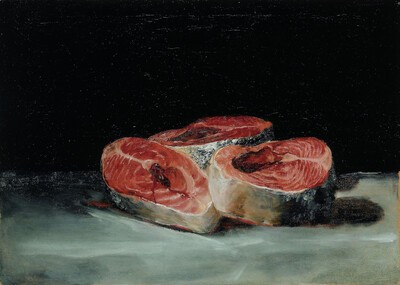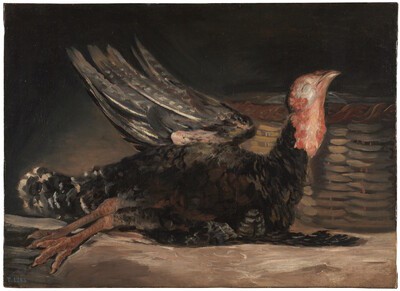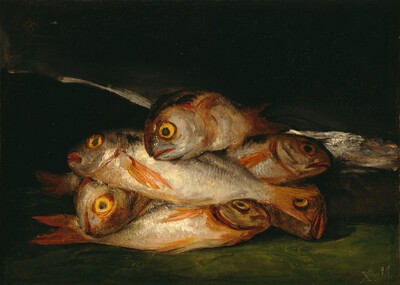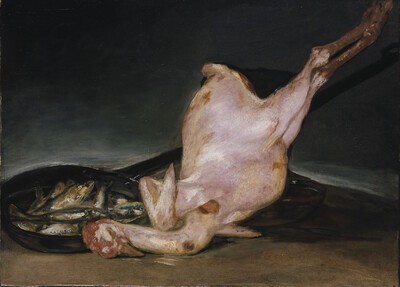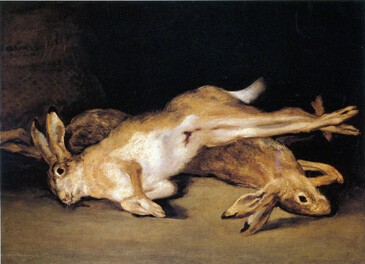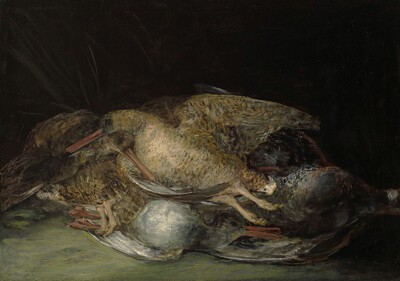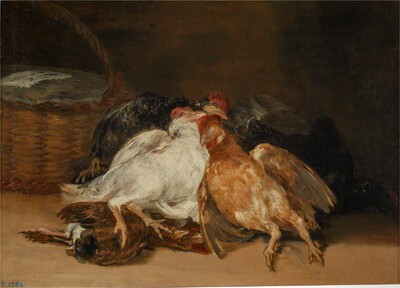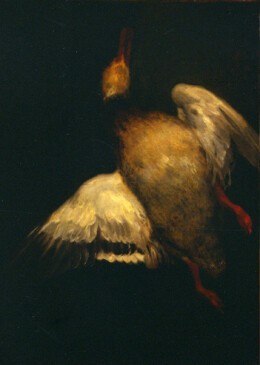- Cronología
- Ca. 1806 - 1812
- Ubicación
- Musée du Louvre, París, France
- Dimensiones
- 45 x 62 cm
- Técnica y soporte
- Oil on canvas
- Reconocimiento de la autoría de Goya
- Documented work
- Titular
- Musée du Louvre
- Ficha: realización/revisión
- 20 Apr 2010 / 15 Jun 2023
- Inventario
- (1937-120)
- Otros títulos:
-
Still Life with Ribs, Loin and Head of a Lamb
Lamb’s Head and Ribs
Head and Loin of a Sheep
Goya (in small red letters, below the sheep's head).
Traces of the letter X in the lower-left hand corner.
Javier Goya inherited this series of still lifes from his father, and in turn left them to his own son, Mariano. When he was unable to repay a loan made to him by the Count of Yumuri, Carabanchel, Mariano gave this set of paintings as security, and in the end the works became the property of the count. When the Count of Yumuri died in 1865 the series of still lifes was sold. Today these works are scattered between different museums and institutions around the world, and some of the paintings have now been lost.
This particular canvas was acquired by the Louvre in 1937.
According to many scholars of Goya's work, the elements which appear in this series of still lifes, which was possibly made during the Spanish War of Independence (1808-1814), are evocations of the many episodes of death and violence that Spain witnessed during those years. The flesh of the animals - inert, discarded material, depicted with a surprising crudeness - could therefore be a reference to the human remains left behind by the violent conflict. Goya perhaps considered the dead bodies of these animals in the same way as he did the human bodies, chopped up and deprived of all dignity, which appear in some of the images in his Disasters of War series of etchings (for example, no. 37, This is worse (Esto es peor), and no. 39, Great deeds! With dead bodies! (Grande hazaña! Con muertos!)).
All of the paintings that make up the series share various formal characteristics which give the set an important sense of unity. In each of them, the animals are isolated from their surroundings, shown in front of a neutral background but drawn out from it by the way the scene is lit.
This series of still lifes represents an important reinvention of the genre, refusing as it did to comply with the way in which themes of this kind had traditionally been treated. We are not, therefore, looking at foodstuffs arranged to decorate and brighten a table; rather, these are dead animals, heaped before us with little care. In these pictures, Goya distanced himself from traditional still lifes such as those by Luis Egidio Meléndez (Naples, 1716-Madrid, 1780) and from the sensuality and opulence of the still lifes of the Dutch painters. In response to the painstaking study of materials and shapes that Meléndez undertook for his works, Goya sets out to capture the whole, which is, in most cases, a mass of lifeless corpses. The only other work to which Goya's series could be linked is The Flayed Ox (1655, Musée du Louvre, Paris) by Rembrandt (Leiden, 1606-Amsterdam, 1669), in which the Dutch artist, just like Goya, has concentrated on the expressive force of the dead matter, later echoed by Chaïm Soutine (Smilovich, 1893-Paris, 1943) in Carcass of Beef (1925, Minneapolis Institute of Arts, Minnesota).
Although we do not know exactly where they were hung, it is believed that these still lifes could have decorated the dining room of Goya's home in Madrid, although they also could have been kept in another room or even in his studio.
In Pieces of Lamb, Goya has painted, on top of a table and in front of a black background, a decapitated lamb's head, turned to face the two crossed slabs of ribs in the centre of the composition, as if looking at them, with an absorbed, impassive, almost resigned expression on its face. The dulled colours and the purplish red help to emphasize the idea of dead meat.
Goya's still lifes heralded the treatment that this genre was to receive at the hands of the naturalist movements of the 19th century. Gudrun Maurer suggests that this painting could have inspired some of the still lifes by Pablo Picasso (Málaga, 1881-Moulins, 1973), particularly the one entitled Still Life with Sheep's Skull (Naturaleza muerta con cráneo de carnero) (1939, Collection of Vicky and Marco Micha, Mexico).
-
GoyaKoninklijk Kabinet van Schilderijen MauritshuisThe Hauge1970organized by Ministerio de Estado y Asuntos Culturales and Réunion des Musées Nationaux, July 4th to September 13th 1970. Exhibited also at the Musée de l’Orangerie des Tuileries, Paris, October 25th to December 7th 1970, consultant editors Jeannine Baticle and A. B. de Vriescat. 35
-
GoyaNationalmuseumStockholm1994consultant editors Juan J. Luna and Görel Cavalli-Björkman. From October 7th 1994 to January 8th 1995cat. 32
-
El bodegón español de Velázquez a GoyaThe National GalleryLondon1995exhibition celebrated from February 22nd to May 21st 1995, curated by Peter Cherrycat. 69
-
Goya, un regard librePalais de Beaux ArtsLille1998from December 12th 1998 to March 14th 1999. Exhibited also at The Philadelphia Museum, Philadelphia, April 17th 1999 to July 11th 1999, consultant editor Arnauld Brejon de Lavergnée and Joseph J. Rishel in collaboration with Manuela B. Mena Marquéscat. 46
-
Goya en tiempos de guerraMuseo Nacional del PradoMadrid2008consultant editor Manuela B. Mena Marqués, from April 14th to July 13th 2008cat. 62
-
Goya: Order and disorderMuseum of Fine ArtsBoston2014cat. 24
-
GoyaBasle2021p. 254
-
Vie et ouvre de Francisco de GoyaParísOffice du livre1970p. 262, cat. 903
-
BarcelonaPolígrafa1970vol. I, p. 353, cat. 596
-
L’opera pittorica completa di GoyaMilanRizzoli1974p. 123, cat. 499
-
Francisco de Goya, 4 vols.ZaragozaCaja de Ahorros de Zaragoza, Aragón y Rioja1980-1982vol. III, p. 187
-
Goya. Arte e condizione umanaNaplesLiguori editore1990pp. 158-160, il. 139
-
El bodegón español de Velázquez a GoyaMadridEdiciones El Viso1995pp. 175, 176, 177, 180, 183 (il.) y 184,
-
Goya en tiempos de guerraMadridMuseo Nacional del Prado2008pp. 240, 241 y 247 (il.), cat. 62
-
Los mundos de Goya (1746-1828)BarcelonaLunwerg2008pp.159-160, il. 91

